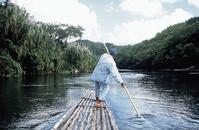Howard Moo Young, Contributor

RAFTING ON THE RIO GRANDE: My first experience down this leisurely river afforded me the opportunity to capture the lush vegetation of Portland. Using a wide-angle lens and polarising filter, I carefully composed the frame to capture the feeling of depth with saturated colours. - Photo by Howard Moo Young
Among the most popular photographic subjects are landscapes and seascapes, especially in the Caribbean's most picturesque island of Jamaica. Yet, one rarely gives the thought and attention that are necessary to
produce striking, effective images. The essence of landscape
photography is the translation of all the different sensory impressions that give the scene its immediate appeal in purely visual terms - to distil several elements into one.
A landscape can be appreciated in a number of ways. As our eyes scan the scene to gradually build up a picture, the photographer takes
in the horizon, the close
foreground, small distant details
and the complete panorama. At the
same time, the movement of light and clouds, the sounds and smells all contribute to the overall impression. The task of a photograph is to produce a visual equivalent of these sensations.
This, in turn, involves analyzing the qualities of the landscape or seascape, selecting the most important ones and then finding photographic ways of interpreting them. In this way, the photograph becomes your personal view, thus assuming a character that snapshots inevitably lack.
Panoramic views
There are two distinct, useful and quite common approaches to landscape photography, each using a different angle of view. Because it often comes closest to the way people experience landscapes, the panoramic view is one of the most popular. This approach tries to convey the broad sweep of a scene with great depth and detail through the use of a wide-angle lens.
In most panoramic views, the relationship between foreground and background is an essential element. By establishing a graphic relationship between an object close to the camera and the horizon, a sense of scale is created and the eye is encouraged to see the image in depth. To achieve this, you must not only choose the camera viewpoint with care - normally quite close to the ground - but also achieve great depth of field, so that both foreground and background are sharp. Fortunately, wide-angle lenses have good depth of field; a small aperture and therefore slow shutter speed are often necessary, however. This is where your tripod becomes an essential tool to help you achieve the sharpest image.
To establish this foreground/background relationship, composition becomes extremely important, the more so because wide-angle lenses tend to include large areas of sky, due to their field of view.
Distant Views
A telephoto or long-focus lens conveys quite a different impression of a landscape. One of its advantages is its ability to magnify and select detail, in the same way that the human eye looks intently at individual elements in a landscape. Whereas the panoramic view is involving - it draws the viewer in to be part of the scene - the distant view that a long-focus lens produces is objective. It carries a feeling of detachment.
Because the angle of view is small, there is more opportunity to select different images from a single viewpoint than there is with a wide-angle lens, so there is more choice of composition. Two important qualities in this kind of landscape image are the compressed planes and altered proportions. The perspective in long-focus images appears to be squeezed while various elements of the landscape tend to arrange themselves into distant planes, stacked one behind the other. In addition, the proportions of objects at different distances are more accurately rendered. The sun, moon, or range of mountains on the horizon, for instance, will appear more imposing.
The many opportunities that present themselves in Jamaica, is a dream for landscape photographers. This is why you should always have your camera ready, especially while travelling through the hills, valleys, and beaches. You never know when you're going to see that gold medal winner just around the next corner. Also, remember that a polarizing filter can transform a landscape at the right time of day, into a spectacular image, as it intensifies the blue skies and subdues unwanted reflections from leaves, grass and water. Try it and see the difference, you will never be without it again.
Here's a reminder to all you camera buffs who seriously want to improve your photography: The Photography Club of Jamaica meets at the Liguanea Club on Wednesday, October 11, at 7:00 p.m. Join us for the next meeting and see if you would like to become a member. The JCDC 2006 medal winners in the Visual Arts Competition are now on display to the public, at the Bloomfield Great House in Mandeville. The exhibition closes on October 12, 2006. There is no charge for admission, and it's a show not to be missed.
-Howard Moo Young is an Advertising / Graphic Design / Photography Consultant with over 40 years of experience. Feedback to mooimages@yahoo.com

